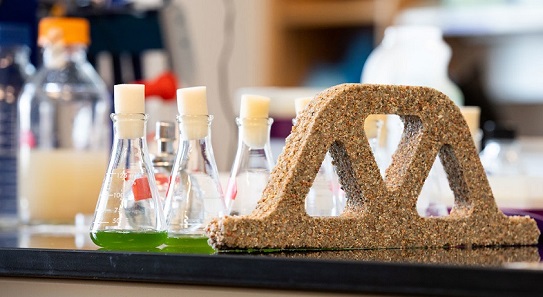Nature manufactures a multitude of complex, hierarchical, multifunctional ‘living’ materials – including bone, wood, tissue, and organs. Advances in modern biotechnology over the past few decades have enabled scalable manufacturing of multiple ‘non-living’ materials (e.g., chemicals, fuels, pharmaceuticals) produced by a variety of wild-type and engineered microorganisms. However, synthetic replication of hierarchical living materials largely eluded scientists and engineers until the advent of a new field-engineered living materials (ELMs).
Scientists and engineers are always pursuing the goals to create a world of living materials that have the characteristics of biological systems: self-replication, self-regulation, self-healing, environmental responsiveness and self-sustainability. The fusion of synthetic biology with classical materials science has yielded breakthrough materials innovations and spawned a new biotechnology field. Engineered Living Materials (ELMs) are defined as engineered materials composed of living cells that form or assemble the material itself or modulate the functional performance of the material in some manner. The integration of functional synthetic materials and living biological entities has emerged as a new and powerful approach to create adaptive and functional structures with unprecedented performance and functionalities. The proposed idea would push the boundaries and frontiers of synthetic biology, materials engineering, nanotechnology, biomaterials, artificial intelligence and directed evolution into new realms which can be summarized as:
- Taxonomic classifications of ELM research highlight states of the art, opportunities, challenges, and emerging trends.
- Opportunities abound to engineer bacteria, fungi, plants, mammalian cells, and diverse consortia of those organisms to produce – and persist within – complex, biologically active materials for applications in therapeutics, electronics, construction, and beyond.
- Principal challenges for the maturing ELM field concern scaling beyond the biofilm, increasing production rates and volumes, engineering consortia of microorganisms, and developing policies related to biocontainment, standardized metrology, and workforce development to address global scientific and engineering challenges.
ELMs are more formally defined as engineered materials composed of living cells that form or assemble the material itself and modulate the functional performance of the material postproduction. To engineer living materials, researchers integrate the disciplines of synthetic biology and materials science. Synthetic biology concerns the application of design–build–test–learn approaches to enable the rational design and re-design of living organisms by genetically engineering them to have new – or enhanced – abilities or useful purposes (e.g., material production, sense-and-respond functionality). By contrast, classical materials science concerns the fundamental study of process–structure–property relationships of natural and engineered materials. Contemporary research has now proven feasible the genetic programmability of organisms to produce – and to persist within – materials with tailorable properties. Inclusion of a living component genetically tailored to participate in material manufacturing and to provide continued biological functions distinguishes ELMs from other science and engineering fields.
The road to ELMs can be strategically broken down to tasks of increasing complexity. First, we need to develop novel design principles to create de novo synthetic biological materials with a wide variety of functional properties namely electrical, mechanical, optical and so forth. A second challenge involves the development of genetic programs and fabrication techniques that ensure the survivability, metabolic activity, and proliferative capacity of the cells over the lifetime of the material. Third, biological circuits that can automatically regulate the production of targeted materials based on the requirement as well as in response to external environmental factors should be developed. Fourth, the developed material should exhibit self-healing capabilities and thereby heal cracks or defects using built-in biological circuits. A fifth challenge is to incorporate self-sustaining capabilities for the engineered material by interfacing its energy feedstock with renewable sources or with other living entities, for example photosynthetic organisms. Sixth, the living material must have symbiotic co-existence in its surrounding eco-system and should not have any harmful implications. Seventh, the most challenging task would be to assimilate all the above characteristics into a single living material. Eight, such living materials can then be subjected to directed evolution to get higher efficiencies and performances.
Vast potential exists for the development of novel, engineered platforms that manipulate biology for the production of programmed advanced materials. Such systems would possess the autonomous, adaptive, and self?healing characteristics of living organisms, but would be engineered with the goal of assembling bulk materials with designer physicochemical or mechanical properties, across multiple length scales. The Engineered Living Materials (ELM) program seeks to revolutionize military logistics and construction in remote, austere, high-risk, and/or post-disaster environments by developing living biomaterials that combine the structural properties of traditional building materials with attributes of living systems, including the ability to rapidly grow in situ, self-repair, and adapt to the environment. Living materials could solve existing challenges associated with the construction and maintenance of built environments, and introduce new capabilities to craft smart infrastructure that dynamically responds to its surroundings. Advances under the ELM program could also improve methods for manufacture and maintenance of military systems such as tanks, planes, and ships. ELM specifically aims to develop design tools and methods that enable the engineering of structural features into cellular systems that function as living materials, thereby opening up a new design space for building technology. The program aims to validate these new methods through the production of living materials that can reproduce, self-organize, and self-heal. Such engineered living materials would also have the ability to respond to their environment in designed ways, self-repairing in response to physical or other stresses, or detecting the presence of specific stimuli such as hazardous compounds.
